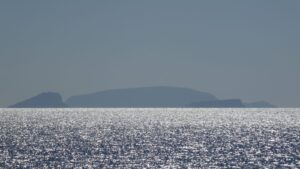
A recent photo sent in by Alan King as he steamed by Syrna (Σύρνα, anciently Syrnos) in the Dodecanese – minuscule and inaccessible, thus happily tucked away from Cycladic summer silliness just to the west – steered us to the Bents’ writings on an islet they were determined to see in early Spring 1888.
Theodore, after a cursory inspection of the terrain around the landing place on April 9th, wrote a note for The Classical Review (1888, Vol. II (10), p.329). If he did remove some of the obsidian blades he refers to, then they are not it seems recorded elsewhere:
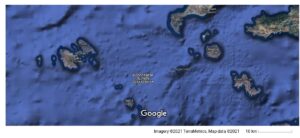
“The small island rock, anciently known as Sirina, now as Agios Joannis, occupies a somewhat important position in the Aegean Sea, as one of the stepping-stones by which the earlier inhabitants of Karia must have travelled westwards; it has two good harbours, one to the north, and one to the south, and is placed midway in a long stretch of sea between Karpathos and Astypalaea, in both of which islands traces of this prehistoric race have been found. Having carefully examined Anaphi, an island lying to the west of this line of route, and having found there no traces whatsoever of this early population, and knowing that Astypalaea, Amorgos, Naxos and Paros are full of their tombs, I was considerably interested in discovering in the ruins of a square fortress on Sirina quantities of obsidian knives, which at once identified this rock with the race in question, and proved to us that they made use of it as a halting-place on their way to and from the marble quarries of Paros; in fact Parian marble, objects of which are so frequently found in their tombs, would seem to have been their chief quest in these westward migrations.”
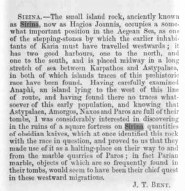
Theodore makes no mention of the hassle getting to this tricky rock. They had hired a fine schooner from Syros a month or so before in early 1888 to cruise up and down the Turkish coast opposite Rhodes, and the skipper, Captain Nikolas, had no intention of breaking her up for insignificant Sirina. But the Bents, as often as not, get their way. Mabel tells the tale in her diary – first a skirmish from her and then a broadside from her husband:
“Sunday [April 8th, 1888]. Well, this morning we set sail, but not before dawn, for Sirina, as we thought, and with the scirocco we should have sailed south of Tilos, which lay directly in our way. We were busy in the cabin, but I peeped up and saw we were steering straight for Nisiros, north of Tilos. So I told Theodore and he proposed to go up and row with the captain, but I said I would make less formal enquiries. I said to [first mate] Grigoris, ‘We are going north of Tilos it seems?’ ‘Yes,’ he said. ‘But very far north! We are going to Nisiros.’ ‘Well! I suppose we shall tack soon, for we shall no doubt pass Tilos as close as we did Rhodes.’ The wind was quite fair for Tilos. He shrugged his shoulders as if to say he could not help it, and I said, ‘How soon shall we tack for the south?’ ‘We are going inside Nisiros.’ ‘But why?’ ‘To go to Kos!’
“So Theodore went up and there was a frightful, awful row. Now Grigoris said he did not wish to go to Sirina at all, and would not go there, and there was no water or harbours and many rocks and no lighthouse and he was always considered a most noble man, and honourable, and so on. ‘Very well’, said Theodore, ‘Go straight to Syra and we will go to the judge and the consul,’ etc.
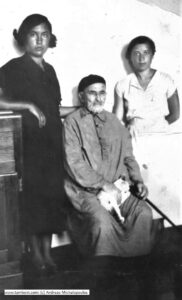
“Later, with [our dragoman Manthaios] as a go-between we said if we could not go south, we did not mind going to a small island called Levitha on the way to Syra. This was agreed upon and we did not care a bit. It rained. I looked out again and saw that now we were going south of Nisiros and close to Tilos, past Kavos Kryos and Kos, where we had agreed to anchor for the night far to the dim north. ‘Where are we going now, Andreas?’ ‘To that place,’ [the crewman replied] very sulkily. ‘What place?’ ‘To Sirina!’ Of course we have lost hours by going so far north and are now fearing a calm.
“Next morning [9th April ] about 10 we reached Sirina and landed after luncheon. We walked across the island to the sea at the other side, where there is a deep bay. Here was a sort of farm, a very irregular enclosure of loose piled stones and very thick walls. The only thing with mortar was the oven. An old woman came out of the dark hut where she was shut in and brought us out little square blocks of wood to sit on, and she directed Theodore to where there were some old stones and so I returned to the ship with one man and the rest went off, but finding the earth all gone and only foundations on rocks they returned, and we set off again in the afternoon.” (Travel Chronicles of Mrs J Theodore Bent, Vol.1, Oxford, 2006, p.252-3).
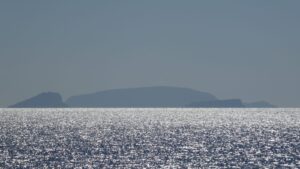
All rather a storm in a seacup, and the frivolous couple’s scamper contrasts unbelievably with the reality of an incident on the island many years later, 7 December 1946, when a medical team,* including Lawrence Durrell as it happens, was sent from Rhodes on a Greek warship to assist the sick and wounded of the vessel Athina Rafiah (originally the SS Athena), carrying Jewish immigrants to Israel, which was wrecked there, with around 800 survivors coming ashore. Sadly eight of the refugees, among them children, perished in the aftermath of the wreck and are buried on the island. There is a lonely monument there to them all.
* ‘With Durrell on Rhodes, 1945-47’, by Raymond Mills, in Twentieth Century Literature, Vol. 33, No. 3, Lawrence Durrell Issue, Part 1 (Autumn, 1987), pp. 312-316.
 Leave a comment or contact us about this article
Leave a comment or contact us about this article